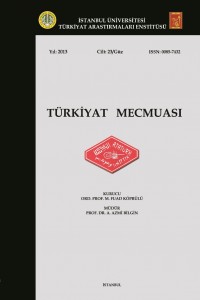Öz
In this study the contribution of the words in the paranthesis to the text, their semantic values and grammatic values will be studied. Theatre scripts are primarily written to be played and put on the stage. Author, transmits the plot to the audiences through the dialogues of heros. The text, which is written in the form of dialogue, gets across with author- reader and author- director- actors- audience. In a drama, personal nouns which show the change of the speaker; time and place words and the words that indicate the emotions and the moves of the people can not be included into the text. These expressions, which can be accepted as diggressions, both provide the reader to envisage the stage and lead the director and the actors in the process of staging. Can the words, conveying semantic value but kept out of the speeches in the context of syntax, be counted as non-textual? Perhaps these words might be thought as a common style of a drama and as a stereotyped form of expression, In this study words types, wordgroups, phrase types and moods which are used as diggressions or non-textual speeches in Turkish will be examined with respect to Haldun Taner’s “Keşanlı Ali Destanı”.
Anahtar Kelimeler
Kaynakça
- ACAROĞLU, Abdüllatif, “Sahne Bilgileri ve Uyumsuz Tiyatrodan Bir Örnek: Eugene Ionesco’nun Kral Ölüyor’u”, Hacettepe Üniversitesi Edebiyat Fakültesi Dergisi, C. 20, S. 1, Ankara 2003.
Öz
Bu çalışmada tiyatro metinlerinde parantez içinde yer alan sözlerin metne katkıları, anlam değerlikleri, gramer yapıları incelenecektir.
Tiyatro metinleri öncelikle oynanmak, sahnelenmek için yazılır. Yazar, olay örgüsünü kahramanlarının konuşmaları vasıtasıyla okuyucuya aktarır. Karşılıklı konuşma biçiminde yazılan eser, yazar-okur ve yazar-yönetmen-oyuncular-seyirci arasında bir iletişim kurar.
Bir tiyatro eserinde konuşanın değiştiğini, konuşma sırasının kimde olduğunu gösteren şahıs isimleri, yer ve zaman sözleri ve kişilerin duygu ve hareketlerini belirten sözler doğrudan metne dahil edilemez. Metinde ara söz de kabul edebileceğimiz bu ifadeler okuyucunun sahneyi zihninde canlandırmasını sağlarken, eserin sahneye konulması aşamasında yönetmen ve oyunculara yol gösterir.
Metin bağlamında anlam değeri taşıyan, ancak sentaks bakımından metni oluşturan konuşmaların dışında kalan sözler metin dışı sayılabilir mi? Belki de bu sözler tiyatro eserlerinin ortak bir üslup özelliği, kalıplaşmış ifade şekilleri olarak düşünülebilir.
Bu çalışmada Haldun Taner'in Keşanlı Ali Destanı metni esas alınarak Türkçede tiyatro metinlerinde ara söz veya metin dışı söz olarak kullanılan kelime türleri, kelime grupları, cümle tipleri ve fiil kipleri incelenecektir.
ANAHTAR KELİMELER:Tiyatro metni, ara söz, metin dışı söz.
Anahtar Kelimeler
Kaynakça
- ACAROĞLU, Abdüllatif, “Sahne Bilgileri ve Uyumsuz Tiyatrodan Bir Örnek: Eugene Ionesco’nun Kral Ölüyor’u”, Hacettepe Üniversitesi Edebiyat Fakültesi Dergisi, C. 20, S. 1, Ankara 2003.
Ayrıntılar
| Birincil Dil | Türkçe |
|---|---|
| Bölüm | MAKALELER |
| Yazarlar | |
| Yayımlanma Tarihi | 28 Aralık 2013 |
| Yayımlandığı Sayı | Yıl 2013 Cilt: 23 Sayı: 2 |


